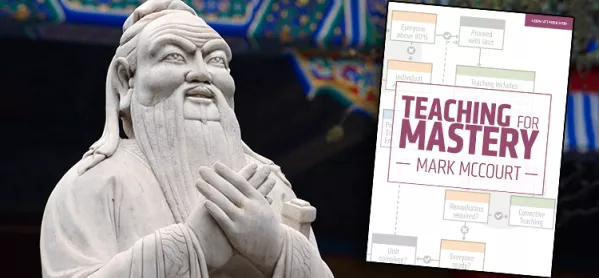- Home
- Book review: Teaching for Mastery
Book review: Teaching for Mastery

Teaching for Mastery
Author: Mark McCourt
Publisher: John Catt Educational
Details: £16, 320 pages
ISBN 978-1912906185
My teenage years coincided with the early success of Terry Pratchett’s Discworld novels. When I first became aware of his work, only five had been published. In those early books, the ideas whizz past with bewildering speed: some brilliant, some just weird, but all carried along with madcap enthusiasm and a continual stream of jokes.
Reading Mark McCourt’s Teaching for Mastery is like being plunged once more into the first Discworld novel, The Colour of Magic - only without the jokes.
Teaching for Mastery is so packed with ideas that, on occasion, you can feel the author dragging himself back from a massive digression with the words “a whole book could be written on…”. I particularly look forward to reading his masterwork on the 320 ideas of school mathematics and the best approaches to teaching each one.
Is mastery too big for one book?
Even without these diversions, there is so much in here that it loses coherence - perhaps the topic of mastery is too big for a single book.
Some of the ideas here are excellent: the clear principle, for example, that everything should be taught correctly first time and not approximated by methods and understandings that work in the specific, simplified context, but are later found not to generalise.
It is also a delight to read a book on education in which technical terms are clearly and explicitly defined - you can tell that it is written by a mathematician. Particularly useful is the distinction between ability and attainment, and the examination of how they can appear identical to a clumsy assessment system. (Attainment is content already learned, and it determines the facility for absorbing new content as surely as ability and speed of learning do).
There is also some beautiful maths, which makes the book worth reading in itself. I particularly enjoyed the application of different bases to the 1089 trick (if you don’t already know this mathematical curiosity, then you should definitely read the book). I also enjoyed this quotation: “How can we, as teachers, be sure that pupils understand arithmetic if they only ever work in one base? All we have shown is that they can perform in one very specialised, limited case.”
Weird ideas
Some of McCourt’s ideas are, like Pratchett’s, just weird. For example, the redefinition of equals to cover a wide range of equivalences: “When given two expressions, applying an isomorphic function to both expressions will result in equivalence holding true.” At the very least, a definition of “equals” that requires, as a prerequisite, the definition of isomorphic functions on expressions is perverse.
Beneath this torrent of ideas, the central thesis of teaching for mastery gets swamped, and it’s easy to forget that what you’re reading is an exposition of mastery teaching as applied to maths. This approach is embodied by the idea, expressed early in the book, that something has not been taught unless it has been learned, and that therefore ticking topics off from a list (the “conveyer belt” approach to teaching) is not a constructive form of curriculum.
A celebration of great teaching
Mastery is knowing something so well that you don’t need to think about it. The gulf in conceptualisation between the master teacher and the novice student is a barrier that has to be overcome with carefully structured and thought-through units of work, where the learning of the content rather than the ticking of a clock determines the moment to move on.
The biggest challenge is how to ensure that all students in an inevitably mixed-ability and mixed-attainment group learn well. But, by the end of the book, I remained unconvinced that the author had found the answer. It may be that this is not a challenge that can be answered by any book, even one as full of ideas as this one.
At its heart, Teaching for Mastery is a celebration of great teaching, and the power of a great teacher. If it is doubtful that the methods described could be effectively adopted by an NQT reading the book - and it is - then there is, at least, no doubt that they are inspiring in the hands of McCourt, and that his classroom is a mathematically glorious, mastery-filled place to be.
Reading the book may leave us breathless, bewildered and daunted, but it also leaves us inspired to do better, and to be better teachers.
James Handscombe teaches maths and further maths A-level at Harris Westminster Sixth Form, where he is also the principal. He tweets as @JamesHandscombe
Keep reading for just £1 per month
You've reached your limit of free articles this month. Subscribe for £1 per month for three months and get:
- Unlimited access to all Tes magazine content
- Exclusive subscriber-only stories
- Award-winning email newsletters



